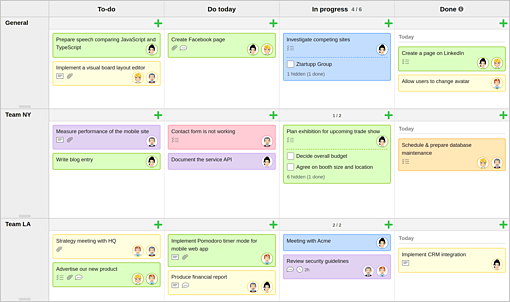 Using Kanban to Manage Scarce Resources
Using Kanban to Manage Scarce Resources
Kanban is one of those tools that is simple yet powerful. It’s very easy to understand and to work with, and its visual nature allows for clearer communication between team members and teams, and makes finding problems obvious for everybody involved. Additionally, Kanban can be incredible helpful when managing a project when resources available are tight and need to be utilized in the best possible ways.
A lot of managers find themselves in a situation when they have to achieve lofty goals, and their team needs to juggle a lot of tasks or projects while they can only rely on scarce resources. A typical Kanban implementation puts a restriction on the number of tasks that can be on the Work in Progress’ section of the whiteboard, which forces teams to collaboratively prioritize and move resources around to make sure things are progressing.
You can learn more about Kanban boards for project teams here >>>
Scope and Limitations
It’s important to note that Kanban is basically a tool, and it cannot be a solution that automatically solves everything or makes resource allocation effective all on its own. It’s most useful as a resource planning tool when applied in the right context, usually during Agile or Scrum implementation, which has strong elements of Lean. It’s not just a matter of making a Kanban board for your daily team meetings, but making sure you follow the Lean thinking and philosophy while doing so. There also needs to be discipline about when the meetings are conducted, what updates to obtain from each person, how long can everyone talk, and rules about what allows the sticky notes to move.
Still, Kanban as a tool has its distinct benefits when dealing with resource scarcity and making sure a team constrained by external and internal factors has the highest possible impact.
The Immense Value of Clarity
One of the most crucial factors that foster process efficiency is clarity. This is especially true when a team has too many tasks on their hands without having enough resources and manpower to make all of them a priority. In this type of situations, the more overworked a team is, the more inefficient it becomes. This is what happens during rush hour traffic, too many cars (tasks) overload the available capacity (number of lanes or road structure). This happens specifically because there is a greater amount of time and effort spent in discussions, decision-making on what to work on neat, and communicating with the management about task prioritization. When things start piling up, many workers become paralyzed with the burden of not knowing how to approach the diverse set of problems that require solutions or action. The kanban board makes this more apparent to everyone, and everyone on the team can help solve it. This disperses a lot of the confusion and lack of clarity in managing projects.
Swim Lanes
While the typical Kanban board only has columns, there is also a possible implementation that includes rows. These rows classify tasks according to their priority, department, or other categorization. Those rows are called “swim lanes” (like in a swimming pool), and they might make comprehending and implementing task prioritization even easier and more effective. A Kanban implementation that includes swim lanes allows both the team members and the people in management to set clear direction and clear priorities.

In the example above, the swim lanes are broken out by 3 regions. Each region has their own lane, and the standard workflow across the columns. When one team gets behind or is struggling to complete a task, it will become clear during the reviews. To make sure the customer is getting what they want, Team NY might need to stop some of their tasks (move items back into the To-do column), and move an item from Team LA into their “Do today” column, so Team LA can focus on the item they are struggling with.
This is the power of kanban boards, to make sure the entire project is moving forward to meet customer needs, not just tracking individuals or team progress.
Check out a past interview related to virtual Kanban boards with Lean Kit CEO Chris Hefley >>>
Become a Lean Six Sigma professional today!
Start your learning journey with Lean Six Sigma White Belt at NO COST






Leave a Reply